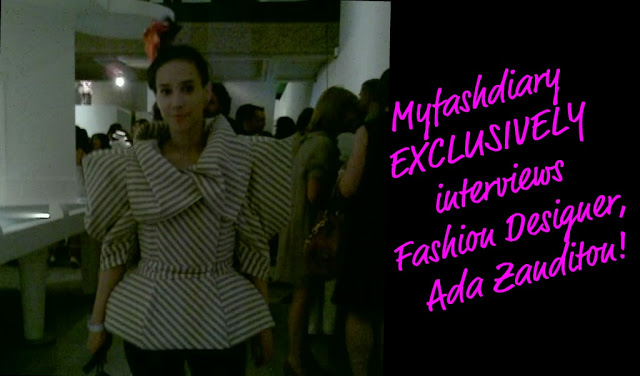EXCLUSIVE Interview with Designer, ADA ZANDITON!
| Credit: Fashion-stylist |
I recently had the opportunity to interview one of my favorite up and coming Fashion designers, Ada Zanditon. What I love even more about Ada is that she is very passionate about the environment, and considers it whilst designing. Check out her latest collection above & her thoughts on Eco Fashion & online fashion in the interview below…
- Hi Ada! When did you realise you wanted to become a fashion designer?
“I remember always wanting to be a fashion designer from about six years old. I loved reading Vogue but also equally loved reading National Geographic and was passionate about the rainforest and loved going to the Zoo. Through becoming an ethical designer interested in creative sustainability I found the synergy between these interests.
“My epiphany happened when I listened to eco-fashion pioneer Katharine Hamnett, talking about the impact of the fashion industry on biodiversity. From this, I realised there was a synergy between my two areas of interest. I knew that my future was to create desirable innovative fashion that benefits people and planet.”
- I love the fact that your designs are so cutting edge and chic, yet ethical! How do you work to achieve eco fashion status?
“I try to consider everything from start to finish of a garment, starting with sustainable fabrics. From seed to growth, weaving, dying and spinning – every process should be as sustainable as possible. That is the mechanics of the brand, the technology and the framework. The handwriting the aesthetic and the image of my brand are sculptural, architectural elegance, unique embellishment and intelligent glamour.
“I love finding great fabrics that are better for both the environment and the customer, such as Tencel and Fairtrade organic cotton. It is really important to me to create desirable fashion that also happens to be sustainable as I think designers bear the responsibility for offering customers a green option without the customer having to compromise.
“I try to make my studio as environmentally friendly as possible by recycling, using and eco-printer, low energy light bulbs, I even grow tomatoes there! It is about living the eco-lifestyle, not just talking the eco message.
- What is the impact of fashion on the environment and what can people do to minimise it?
“Fashion impacts on the environment in several different ways including the way materials are produced, how they are transported and the amount of waste that is produced.
“We can all do very simple things too like washing at 30 degrees – it really saves energy as washing clothes has a very big impact. I think developing a sense and confidence in your personal style and wherever possible getting the best quality for what you can afford rather than buying the cheapest things in bulk.”
- You have partnered with Ecover to highlight how people care for their clothes. Why do you think this is important?
“With all fashion, so much effort goes into the production of the garment, but the biggest impact on the environment often occurs post-purchase. This is even more important with eco-fashion – why purchase an organic dress to then wash it in a fabric softener that will cause chemical damage to the water system?
“Ecover is ecological from start to finish, from sourcing ingredients to methods of production, even taking into account impact of the products after use; these are all things that I have to consider from start to completion of every garment. Choosing an ecological product for the care of your clothes is an easy choice to make and knowing that you are contributing and making a difference feels good too. Using eco-laundry powders and fabric softeners like Ecover completes the lifecycle of an eco-fashion garment.”
- Could you share some eco-fashion tips? What should we look for and how can we switch to eco fashion?
“The easiest way to switch to eco-fashion is to look at what you already wear and find the ethical alternative. Useful places to look are on the British Fashion Council’s website, which has links to stockists, or on the Young British Designers’ website. Most of the designers operate from the UK. The internet is a great tool for this information.
“Once you start looking at one eco-brand, it will lead you on to another and then another. Years ago there was only one brand, with one product, but now there are lots of brands doing different things – it leaves lots to be explored in the world of eco-fashion.”
- Fashion magazines or fashion blogs?
“I think I would have to sit on the fence here and say both. I love fashion blogs, it’s such a quick an easy way to access the latest insight into the industry and it’s great that people can share their inspiration and ideas this way. To me, fashion blogs are the evolution of fashion magazines, but the magazines will always be important and I could never give up my Vogue!”
- What is next for Ada Zanditon?
The next step for the brand is to continue to grow sustainably both here in the UK and internationally, seeking to collaborate with other innovators and evolve the brand to encompass more than fashion in the long term. Ideally one day Ada Zanditon will be a leading eco-lifestyle brand providing innovative, desirable products that have synergy between people, planet and profit.
- Last words for myfashdiary readers?
Believe in value, value is a long-term commodity. Value, quality and a sense of style are the long lasting elements that are part of how we create our world and our identity. If we don’t value what we have because it is not valuable, it gives us a much less important sense of what we have and how we use it.







